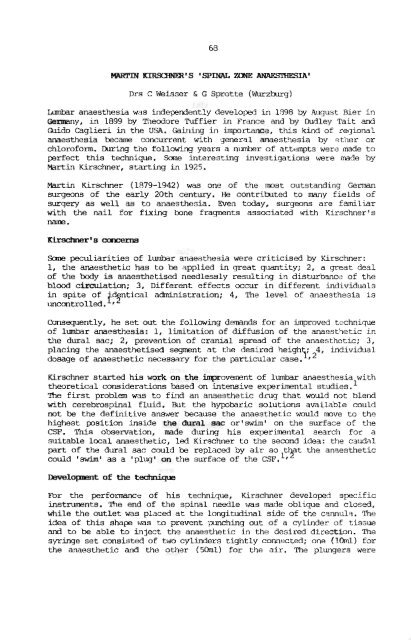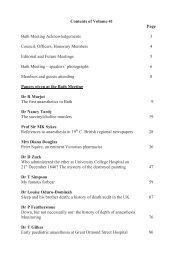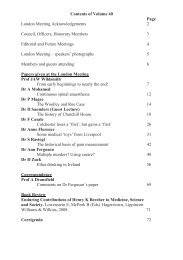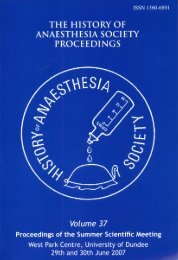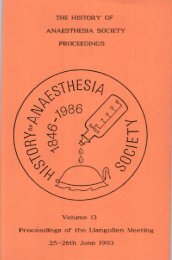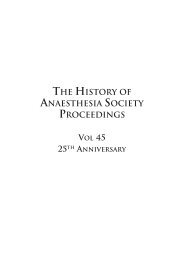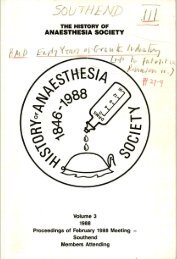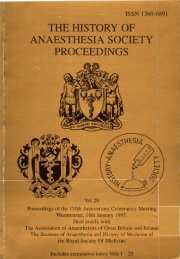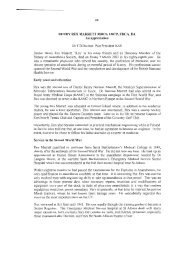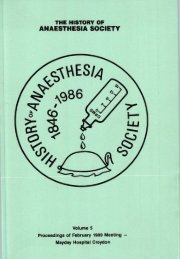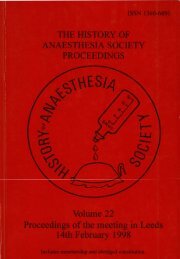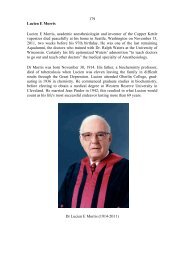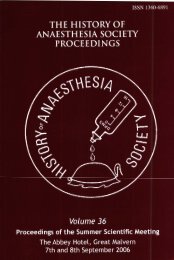Volume 9b - History of Anaesthesia Society
Volume 9b - History of Anaesthesia Society
Volume 9b - History of Anaesthesia Society
Create successful ePaper yourself
Turn your PDF publications into a flip-book with our unique Google optimized e-Paper software.
Drs C Weisser & G Sprotte (Wurzburg)<br />
Inntar anaesthesia was independently developed in 1.998 by k~gust Bier in<br />
Germany, in 1899 by 'll~heodore Tuffier in France and by Wley Tait and<br />
ado Caglieri in the USA. Gaining in importance, this kind <strong>of</strong> regional<br />
arnesthesia became concurrent with yener31 anaesthesia by other or<br />
chlor<strong>of</strong>orm. Wing the follaving years a n~mhr <strong>of</strong> attempts were made to<br />
perfect this technique. Some interesting investigations were made by<br />
Martin Kirschner, starting in 1925.<br />
Martin Kirschner (1879-1942) was one <strong>of</strong> the most outstanding G e m<br />
surgeons <strong>of</strong> the early 20th century. He contrihted to many fields <strong>of</strong><br />
surqery as well as to anaesthesia. Even today, surgeons are familiar<br />
with the nail for fixing bone fraqments associated with Kirschner's<br />
name.<br />
Some peculiarities <strong>of</strong> lumbar anaesthesia were criticised by Kirschner:<br />
1, the anaesthetic has to be applied in great quantity; 2, a Teat deal<br />
<strong>of</strong> the body is anaesthetised needlessly resulting in disturbance <strong>of</strong> the<br />
blood circulation; 3, Different effects occur in different individuals<br />
in spite <strong>of</strong> d ntical administration; 4, The level <strong>of</strong> anaesthesia is<br />
uncantrolled . i, S<br />
Consequently, he set out the following dernands for an improved technique<br />
<strong>of</strong> lumbar anaesthesia: 1, limitation <strong>of</strong> difkion <strong>of</strong> the anaesthetic in<br />
the dural sac; 2, prevention <strong>of</strong> cranial spread <strong>of</strong> the anaesthetic; 3,<br />
placing the anaesthetised segment at the desired heigh 4, individual<br />
dosage <strong>of</strong> anaesthetic necessary for the particular case. y2<br />
Kirschner started hie work on the improvement <strong>of</strong> lwhr anaesthesia with<br />
theoretical considerations based on intensive experimental studies.'<br />
The first problem was to find an anaesthetic drug that would not blend<br />
with cerebmspinal fluid. Wlt the hypobaric solutions available could<br />
mt be the definitive answer because the anaesthetic would move to the<br />
highest position inside the dural sac or'swim' on the surface <strong>of</strong> the<br />
CSF. This observation, made during his experimental search for a<br />
suitable local anaesthetic, led Kirschner to the second idea: the cmdal<br />
part <strong>of</strong> the dural sac could be replaced by air so t a t the anaesthetic<br />
could 'swimm as a 'plug' on the surface <strong>of</strong> the CSF.'tS<br />
~ o p u e l r<strong>of</strong> t the t-<br />
For the perfonmxe <strong>of</strong> his technique, Kirschner develop3 specific<br />
instruments. The end <strong>of</strong> the spinal needle was made oblique and closed,<br />
while the outlet was placed at the longitudinal side <strong>of</strong> the camula. Tne<br />
idea <strong>of</strong> this shape was to prevent pmching out <strong>of</strong> a cylinder <strong>of</strong> tissue<br />
and to be able to inject the anaesthetic in the desired direction. The<br />
syringe set consisted <strong>of</strong> two cylinders tightly connected; one (10ml) for<br />
the anaesthetic and the other (50ml) for the air. The plungers were


